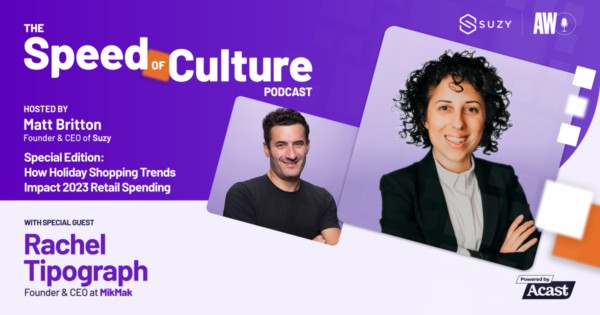In this episode of The Speed of Culture Podcast, Suzy Founder and CEO Matt Britton chats with Rachel Tipograph, founder and CEO of MikMak, an enablement and analytics platform for multichannel ecommerce brands.
After working at Gap as the youngest-ever global director of digital and social media, Tipograph founded MiMak in 2015. Today, the platform provides capabilities that power over 600 leading brands including Amazon, Walmart, Target and Instacart. Since founding MikMak, she was spotlighted in Adweek’s 2016 Young Influentials issue and featured in major publications such as Forbes, Fast Company, Entrepreneur and Business Insider. She also co-hosts the Brave Commerce podcast with Sarah Hofstetter, president of Profitero.
Tipograph shares wisdom gathered from MikMak’s proprietary data on consumer spending habits over the past few years and how brands are positioning themselves. Listen to learn more about how consumers are spending in the post-pandemic economy, how companies are responding to spending habits, the current landscape of the ecommerce market and how marketing will change in the coming years.
Stream the new episode below, listen and subscribe on Apple Podcasts or find it on Spotify.
Key highlights:
- 05:31-11:25—The state of post-pandemic spending—There are several reasons consumers spent much less in 2022 than in the past two years. A dip in the economy is one. People are concerned with saving during economic downturns. Tipograph says that consumers are trading down: “Instead of buying the $150 bottle of whiskey, maybe you’re going to buy the $75 bottle.” High interest rates and debt are also significant factors. People aren’t buying houses due to high mortgage rates, and the “buy now, pay later” market contributes to a growing debt among Gen Zers and millennials.
- 12:06-17:02—Trends in the retail market—Tipograph says that people have overall reduced their shopping by 30%. While Black Friday saw year-over-year growth in online sales, people across the U.S. spent more on baby formula than on gifts. To account for this, retailers must shift gears as consumers pay less for nonessential products. Companies that are successful sell more household items, like groceries and alcohol.
- 22:00-24:32—Winning is ultimately about brand trust—Physical retailers who win are investing in brand building. Performance and optimization matter, but brand trust is the ultimate goal, and storytelling and packaging are still incredibly powerful. Target’s private grocery label, Good and Gather, made $1 billion in revenue in 2020. Walmart and Amazon are also big players in this space.
- 29:06-32:50—The rise of the private label—Corporations like Walmart, Target and Amazon have a massive advantage over brands because they own the shelf space. And during economic downturns, consumers often switch to private label to save a little money. Brands that want to avoid private label market share creep need to invest in branding.
- 35:59-38:37—The Twitter debacle and TikTok trends—MikMak’s Twitter traffic declined by 100% after Musk took over. TikTok is positioned perfectly to take that market share. As TikTok traffic rises, more brands are spending on the platform. Tipograph says we will see more of a blend between retail and social media in the near future.
- 42:01-37:07—2021 vs. 2022: Black Friday—People are still buying more necessities but are willing to show up for deals. Despite what many economists predicted, there was an uptick on Black Friday. Year-over-year growth was up 2.5% from last year, and that number is down from 16% last year. Instacart won big on Black Friday; they got a high conversion rate with same-day delivery guaranteed.
- 49:42-57:00—Marketplace strategies for specialty retailers—Specialty retailers need to focus on marketplace strategy. “Buy online, pick up in-store” is very profitable. Tipograph advises specialty retailers to go niche. Delivering specialty at scale is a different challenge. Successful examples include Petco, which rebranded as a pet wellness company.
54:26-57:06—Tipographs’s predictions—CTV will grow, plus programmatic websites and influencers are here to stay. Retail media will also be a big player in the game.
Source link




